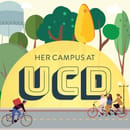The Trump administration recently coined terms like “alternative facts” and “fake news” to discredit the mainstream media. Prior to this sort of censorship, American libraries and school systems had removed or challenged certain books with the the intent of protecting others (usually children and young adults) from “difficult ideas and information.” Especially in this current political climate, it’s important to preserve — not censor — diverse narratives regardless of the contentious or disagreeable material they contain. Like most other works of literature, banned books nuance what it means to be human and compel readers to think about the sociopoliitical aspects of their communities.
The following list reveals titles of 10 banned/frequently challenged books and their reasons for which they were censored, despite their constructive impact and influence.
1. 1984 by George Orwell
Courtesy of Houghton Mifflin Harcourt
Published: 1949
Synopsis: The novel is a political fiction and dystopian science-fiction that depicts the dangers of a totalitarian regime.
Reason: Many thought Orwell’s novel was “pro-communist” and that it contains “explicit sexual matter.” (Jackson County, FL; 1981)
2. Anne Frank: The Diary of a Young Girl
Courtesy of Random House Adult Trade Publishing Group
Published: 1947
Synopsis: This nonfiction book contains excerpts from a diary kept by Anne Frank while she was in hiding for two years with her family in the Nazi-occupied Netherlands.
Reason: It has been challenged and censored for its “graphic” language (i.e., depictions of sexuality) and is often considered “too depressing.”
3. To Kill a Mockingbird by Harper Lee
Courtesy of J. B. Lippincott & Co.
Published: 1960
Synopsis: The novel focuses on six-year-old Scout Finch who lives with her older brother and their widowed father, who is a middle-aged lawyer. This coming-of-age story shows Scout learning empathy through her interactions with marginalized people within her Southern town — namely their reclusive neighbor “Boo” Radley and Tom Robinson, a black man convicted of raping a white woman.
Reason: It is often challenged for its “profanity” and “adult themes such as sexual intercourse, rape, and incest.” Also, the book’s use of racial slurs was thought to promote “racial hatred, racial division, racial separation, and promotes white supremacy.” (Middle school in Brentwood, TN; 2006)
4. The Catcher in the Rye by J.D. Salinger
Courtesy of Little, Brown and Company
Published: 1951
Synopsis: This novel depicts a runaway teenage boy grappling with his impending adulthood and his notions of masculinity whilst running around New York City.
Reasons: The book contains “excess vulgar language, sexual scenes, things concerning moral issues and excessive violence.” (Library in Morris, Manitoba; 1982)
5. The Color Purple by Alice WalkerCourtesy of Houghton Mifflin Harcourt
Published: 1982
Synopsis: Narrated by the poor and uneducated Celie, this story depicts the life of black women in the 1930s American south and addresses their exceedingly low position in society.
Reason: The book was rejected because of its “rough language” and “explicit sex scenes.” (School in Hayward, CA;1985)
6. Fun Home by Alison Bechdel
Courtesy of Turtleback Books
Published: 2006
Synopsis: This graphic novel chronicles the author’s complex relationship with her father while addressing themes of sexual orientation, gender roles, suicide, dysfunctional family life, and the role of literature in understanding oneself.
Reason: Attempts to ban the novel had been based on claims that it is “pornographic,” immoral, and anti-Christian.
7. Lolita by Vladimir Nabokov
Courtesy of Penguin Random House
Published: 1955
Synopsis: A middle-aged man becomes fixated with and then sexually involved with a 12-year-old girl after she becomes his stepdaughter. The book explores themes of exile, innocence, and American consumerism.
Reason: It was banned for being “obscene” in France (1956-1959), England (1955-59), Argentina (1959), and New Zealand (1960).
8. Native Son by Richard WrightCourtesy of Turtleback Books
Published: 1940
Synopsis: The novel tells the story of 20-year-old Bigger Thomas, a black man living in poverty in 1930s Chicago. On the whole, the novel portrays the systemic inevitability behind Bigger’s crimes and misdoings.
Reason: The novel is often challenged due to its depiction of “violence, sex, and profanity.”
9. The Great Gatsby by F. Scott FitzgeraldCourtesy of Simon & Schuster
Published: 1925
Synopsis: The story primarily follows the mysterious and seemingly wealthy Jay Gatsby and his obsession with the beautiful Daisy Buchanan. Often considered a portrait of the Jazz Age, the novel explores themes of decadence and American idealism.
Reason: The book contains “language and sexual references.” (Baptist College in Charleston, SC; 1987)
10. The Harry Potter books by J.K. RowlingCourtesy of Scholastic
Published: 1997-2007
Synopsis: The series follows young wizard Harry and his constant struggle to live up to a legacy he didn’t ask for and surviving the trials it entails — with the help of other wizard allies and friends. Again and again, Harry discovers the value of friendship and the power of unconditional love.
Reason: They “promote witchcraft,” set “bad examples” and are “too dark” according to many schools.
*The pictures do not belong to the author or Her Campus UC Davis.

